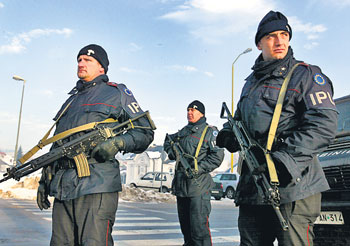
NATO, pushing 60, will grapple with new and old threats at summitIn Afghanistan, it is battling al-Qaeda and Taliban. In newly independent Kosovo, it's up against Serbian protesters armed with firebombs and grenades. And behind the scenes, it is helping to quell the violence in Iraq and to track down suspected war criminals in Bosnia. NATO, its chief insists, has no ambitions to become a "global policeman." But the military alliance born of the Cold War continues to grow and face new challenges. At a summit Wednesday through Friday in Romania, U.S. President George W. Bush and the leaders of NATO's other 25 countries will discuss how to mobilize more troops to turn the tide in Afghanistan, and whether to get bigger and tougher at the risk of alienating Russia.
The North Atlantic Treaty Organization, which turns 60 next year, faces a mid-life crisis as it debates whether a new vision and direction are needed in a world transformed since the Cold War that was the alliance's original raison d'etre. Its membership has nearly doubled since the Berlin Wall came down, and the venue of the summit - the cavernous "People's House" in Bucharest built by Nicolae Ceausescu, Romania's last communist dictator - is a powerful symbol of a world upended. Yet echoes of the Cold War persist in NATO's confrontation with Russia. Already, with nine former Soviet bloc countries in its ranks, NATO abuts some of Russia's borders and could soon reach others as Bush and other NATO members seek to bring Georgia and Ukraine aboard, much to the Kremlin's dismay. But some NATO members - notably France and Germany - are uneasy about provoking Russia, which fiercely opposes the eastward expansion of an alliance it denounces as a Cold War relic. U.S.-Russia relations already have chilled over Washington's recognition of Kosovo's independence and U.S. plans to base a missile defense system in the Czech Republic and Poland, two ex-Soviet satellites. In a conciliatory gesture, NATO invited outgoing Russian President Vladimir Putin and his hand-picked successor, Dmitry Medvedev, to meet with leaders on the final day of the summit. It will be Medvedev's first international outing as president-elect. But the gathering could be a platform for controversy and widen the Europe-North America divide, says Marek Swierczynski, a commentator for the Atlantic Community, a Berlin-based forum on security and defense issues. "That will be very dangerous," he said. The advent of global terrorism may prove to be NATO's undoing, said Stanley Kober, a research fellow at the Cato Institute, a libertarian think tank. "During the Cold War, when we stood up against the Russians, they would back down. Our enemies today are not afraid of us - they keep coming," he said. "And history shows us that alliances don't survive. They all end in divorce." NATO Secretary General Jaap de Hoop Scheffer told a recent conference in Brussels that the 26-nation alliance is stretched thin."The burdens on NATO are greater today than ever before, and this makes it ever more urgent that we have a clear strategic vision," he said. "We need to answer the question: What kind of NATO do we want for the years to come?" For starters, apparently a larger one - if only to ensure the organization remains what de Hoop Scheffer calls "a military insurance policy." At the summit, NATO leaders are expected to formally invite Croatia, Albania and perhaps Macedonia to join, expanding the alliance's boot print in the Balkans. Afghanistan is expected to overshadow the summit, which will also draw Afghan President Hamid Karzai and U.N. Secretary-General Ban Ki-moon. NATO's force is about 43,000-strong, but commanders are pleading for more troops in the south, where Taliban insurgents are wreaking the most havoc. "The problem with Afghanistan is that it's eclipsing the summit just as it did in Riga in 2006," when NATO held its last big meeting, said Julianne Smith, Europe program director for the Center for Strategic and International Studies, a Washington think tank. "It kind of sucks the oxygen out of the room right now." Most of the fighting is done by troops from the U.S., which contributes about a third of the Afghanistan force, and from Canada, Britain and the Netherlands. France, Spain, Germany, Italy and Turkey keep forces in more peaceful parts of the country. Non-NATO Australia, which has sent 1,000 troops, has set an ultimatum - that NATO offer a new battle plan with clear benchmarks for victory. Canada is also pressing the alliance for reinforcements for its 2,500 troops in dangerous Kandahar province, and made that a condition for extending its commitment in Afghanistan to 2011. Yet many Europeans "don't think of Afghanistan as their fight," said Stephen Larrabee, a senior security expert for the RAND Corp. think tank."During the Cold War, you had a consensus on who the enemy was," he said. "In the post-Cold War era, you don't have a common enemy - you have very diverse threats and challenges." And some of NATO's newcomers are struggling just to move troops and helicopters around."We've got a severe capabilities problem. It seems as though we're limping along a bit," said Smith."This isn't the military alliance that many of us had in mind as we celebrated the end of the Cold War."
Kosovo also will resurface at the summit. |
|
||||||
|| Front
Page | News | Editorial | Columns | Sports | Plus | Financial
Times | International | Mirror | TV
Times | Funday
Times || |
| |
Reproduction of articles permitted when used without any alterations to contents and a link to the source page.
|
© Copyright
2008 | Wijeya
Newspapers Ltd.Colombo. Sri Lanka. All Rights Reserved. |
